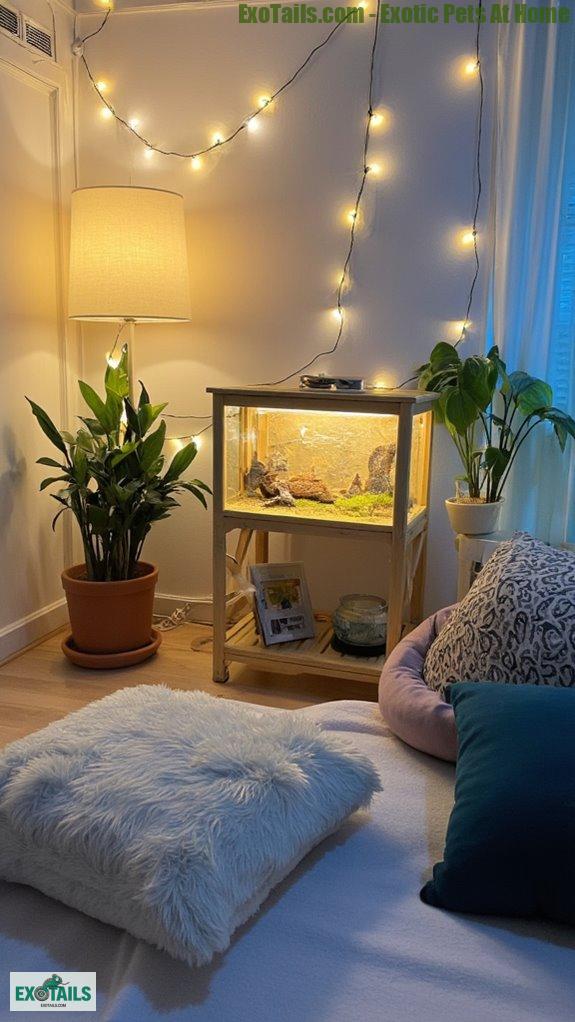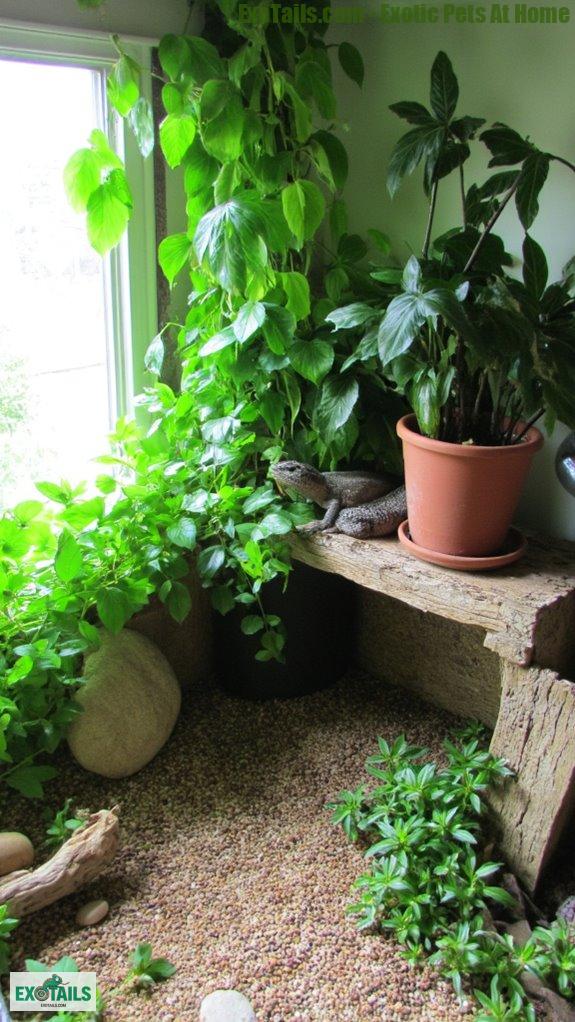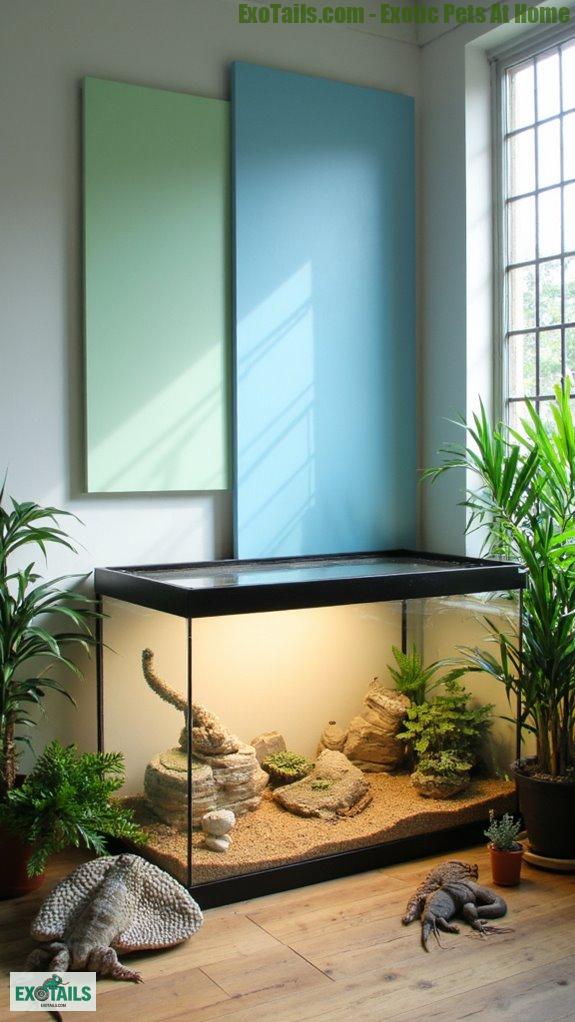Quiet Reptile Habitat: 8 Calm Decor Tips for Homes
If you want a quiet reptile habitat, consider using natural materials like bamboo and cork to create a soothing vibe. Soft lighting with gentle colors can really set the mood, and cozy Zen zones with moss and small fountains help your scaly friends feel right at home. Don’t forget to add some plant life for a splash of freshness, while keeping things clutter-free for their comfort. Curious about more tips? There’s so much more to explore!
Quick Takeaways
- Use natural materials like bamboo and cork to create a serene and earthy ambiance in your reptile habitat.
- Opt for soft lighting with dimmable LEDs to mimic natural light cycles and enhance relaxation.
- Incorporate zen zones with natural features, such as moss bedding and water fountains, to promote tranquility.
- Enhance aesthetics and air quality by including indoor plants that provide hiding spots and stimulation for reptiles.
- Minimize clutter by using smart storage solutions and focusing on a few key decor elements for a tidy environment.
Choose Natural Materials

When setting up your reptile habitat, choosing natural materials is like picking the right outfit for a special occasion—it’s all about making the perfect impression!
Setting up your reptile habitat with natural materials is essential for creating a stunning and comfortable space.
Think about bamboo accents; they add a touch of the outdoors and help your reptile feel right at home.
Plus, who wouldn’t want a sleek, eco-friendly look?
And let’s not forget cork flooring! It’s not only stylish but also mimics the natural world, allowing your critter to explore safely.
Additionally, opting for natural substrate options can help maintain humidity levels that are essential for your reptile’s health.
Trust me, I’ve dabbled with exotic pets and home decor for ages on my site, ExoTails.
You want your space to be both fabulous and functional, right?
Incorporate Soft Lighting

Incorporating soft lighting can really transform the space. I love using ambient colors—think soft blues or gentle yellows. These shades truly enhance the mood, creating a calming environment for both you and your pets.
Have you ever sat in a dimly lit room and felt instantly relaxed? That’s the vibe you want! By strategically placing lamps or using dimmable LEDs, you gain control over the habitat’s ambiance. Additionally, a well-structured dynamic lighting schedule can help mimic the natural light cycles that reptiles thrive on.
Trust me, your reptile will appreciate it as much as you do.
ExoTails thrives on creating these peaceful settings—join me on this journey!
Establish Zen Zones

Here’s a simple table to visualize this:
| Zen Zone Ideas | Elements to Include |
|---|---|
| Soft Bedding | Natural materials, like moss |
| Water Features | Small fountains, pebbles |
| Cozy Hides | Shelters, leafy greens |
| Natural Decor | Driftwood, rocks |
With ExoTails, I’ve discovered that embracing these spaces makes a big difference! Adding burrowing-friendly materials to your enclosures can enhance your pets’ comfort and well-being.
Use Subtle Colors

While you might think vibrant colors are essential for a reptile habitat, I can assure you that subtle colors can create a soothing environment that benefits both your pet and your own sense of calm.
Pastel palettes and muted tones set a perfect backdrop, allowing your reptile to stand out without distractions.
Isn’t it invigorating? Think of how inviting soft greens and gentle blues feel, compared to chaotic brights.
As I designed my own reptile space, I learned that control over aesthetics isn’t just stylish; it’s relaxing.
Let’s create a serene haven together, where subtlety reigns supreme and calm is the goal!
Add Plant Life

Incorporating plant life into your reptile habitat isn’t just about giving it a touch of greenery; it’s like adding personality and charm to your little ecosystem.
Indoor plants, like pothos or spider plants, aren’t just pretty; they’re natural air purifiers, too! Why not let your reptile breathe a little easier?
Plants provide hiding spots, stimulation, and a touch of nature that can calm both you and your pet.
Plants create cozy hideaways and bring a soothing slice of nature, enriching your pet’s world and yours.
When I designed ExoTails, I wanted to create space for combining aesthetics with care, and trust me, your scaly friends will appreciate the upgrade—just watch them bask among the leaves!
Minimize Clutter

When you think about decorating a reptile habitat, clutter mightn’t be the first thing on your mind, but trust me, it makes a big difference! A tidy space doesn’t just look good; it makes your reptile feel more secure, too.
Here are some decluttering strategies I swear by:
- Use smart storage solutions, like labeled bins for supplies.
- Limit decorative items to 2-3 focal points.
- Keep only essentials for your reptile’s health.
- Regularly assess and remove unused items.
Create Sound Barriers

Creating a peaceful environment for your reptile doesn’t have to be complicated. I’ve spent years crafting my space and found that soundproof panels can truly change the game.
These panels help block out ambient noise, creating a serene haven for your cold-blooded friend.
Have you ever noticed how much noise surrounding pets can pick up? It’s wild! By installing these panels, you’re not just decorating; you’re actively protecting their peace.
Trust me, your reptile will thank you for the calm vibes. Plus, it makes for a stylish home.
With ExoTails, I wanted to share these essentials for tranquil habitats.
Opt for Acoustic Decor

Opting for acoustic decor can make a world of difference in your reptile’s habitat, and let’s be honest, who wouldn’t want to create a chill zone that doubles as a stylish home?
Creating a serene and stylish habitat for your reptile can transform their space and enhance their well-being.
Here are some acoustics solutions and soundproofing techniques to ponder:
- Acoustic Panels: These soft, stylish panels absorb sound and come in various designs.
- Heavy Curtains: Thick drapes not only keep heat in but also muffle noise.
- Rugs: Placing area rugs on hard floors can considerably dampen sound.
- Plants: Strategically placed greenery acts as a natural sound barrier.
Trust me, a calmer space means a happier reptile!
Designing Cozy Pet Spaces

There’s something special about designing cozy spaces for our scaly companions that truly brings a home to life, don’t you think? Cozy bedding and temperature regulation are key elements that contribute to a reptile’s comfort. Here’s a quick guide to help you create that perfect space:
| Cozy Element | Description |
|---|---|
| Soft Substrate | Adds warmth and comfort |
| Hiding Spots | Helps reduce stress |
| Heat Mats | guarantees proper temperature |
| Foliage | Creates a natural vibe |
| Cozy Bedding | Offers a snuggly retreat |
Questions and Answers
What Reptile Species Thrive in Quiet Home Environments?
When considering reptile care, I’ve found that species like crested geckos and ball pythons thrive in quiet habitats. Thoughtful habitat design, including proper lighting and temperature, really makes a difference in their comfort and health.
How Often Should I Rearrange My Reptile Habitat Decor?
I rearrange my habitat decor every few months to keep it fresh and maintain aesthetics. A decor rotation not only enhances the visual appeal but also gives my reptile a stimulating environment for exploration and comfort.
Can I Use Artificial Plants in Reptile Habitats?
Sure, I’ve used artificial plant types in my reptile habitats, and they’ve added aesthetic appeal without the hassle of maintenance. The benefits of decor like this include durability and a stress-free environment for my pets.
What Should I Avoid When Designing a Reptile Habitat?
When designing a reptile habitat, I avoid noisy materials and anything that can create disturbances. Ensuring a calm environment with proper habitat materials is essential for my reptile’s well-being and stress reduction.
How Do Different Colors Affect Reptile Behavior?
Ever wonder how colors shape your reptile’s mood? I’ve found that color psychology influences their behavior markedly. Choosing calming hues enhances habitat aesthetics, giving you more control over their environment and well-being.







